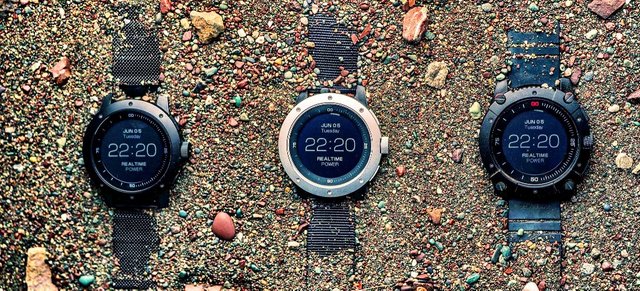
The Matrix Powerwatch 1 (also known as "OPW", Original PowerWatch, or Series 1) hit the market in 2018 and raised a lot of attention with a captivating tagline (“The world’s first smartwatch powered by you”) and the enticing promise of solving one of the most critical issues affecting smartwatches – the constant need of tethering to a charger to keep running. After three years of ownership and several months running on the final firmware v2.17, it is time to gather all the results and provide a definitive experience review.
Thermoelectric generation is science, not magic, but it quite feels like.
The human body disperses heat, that can be harnessed and (thanks to the Seebeck Effect) converted to energy. This principle leverages the temperature difference between two sides of a semiconductor, namely your skin (warm side) and the surrounding environment (cold side). The science behind that is anything but new – dating back to 1821 – but practical applications have been hampered by drawbacks, mostly related to low efficiency in the conversion process. While the average human body radiates nearly 100 watts of heat, more than 50% of it comes from the head and a typical wrist-sized device can collect and generate less than a measly 200mV of tension. These are not enough to power anything useful. However, the folks at Matrix Industries claim their unique booster circuit can amplify that tension up to 3-4 Volts, and have designed the Powerwatch around it.
In layman’s terms, this allows a wearable device to be continuously powered by body heat (which is always available, at least as long as the person is alive) and never require actual charging. Things go even better if the user generates more heat (e.g. during workout). This poses the premise to disrupt a world where smartwatches and fitness trackers require to be plugged in and charged almost every day.
It’s not the first, but it is the first that actually works.
Given how long has passed since the Seebeck Effect was formulated, one would expect watch manufacturers had already implemented it – and that is correct.
In 1980 Bulova presented a prototype of their Thermatron, a watch that used body heat from the wrist to charge the battery that supplied the quartz movement with energy. Unfortunately, by the time of its commercial availability in 1982, the technology was not reliable despite years of development; for instance it only had a few days of power reserve and, if the internal capacitor ran out of charge, the watch could not self-recharge even if worn and had to be returned to the factory. Despite this and other shortcomings an executive decision was made to push it to production with a steep price of $2,000 ($5,240 equivalent in 2018). The Thermatron was a big commercial flop. Production was stopped after only 500 pieces and is considered to have played a key role in causing Bulova to go bankrupt, as the massive investment in developing this new technology failed to generate any profit.
In December 1998 Seiko introduced the Thermic, also a quartz movement powered by body heat harvested by Seebeck Effect. With a price tag of 300,000 Yen ($3,980 equivalent in 2018), it made the headlines and became an instant classic but quickly moved from expensive novelty to exotic collectible.
These two wearables represented all the commercial attempts at using thermoelectric, as quartz watch manufacturers looking for alternative power sources progressively adopted kinetic rotors and photovoltaic cells. They offered clear advantages: simpler and more efficient, they could be more easily integrated with existing movements, but more crucially they were cheaper to manufacture and based on proven, reliable technology. Solar-powered watches became more common and thermoelectric solutions were quickly forgotten.
Given all these premises, the Matrix Powerwatch raised a lot of interest and deserved an accurate insight.
Does it really work?
Yes. With regards to the single most important question, the Powerwatch fulfills its promise of quasi-magical uninterrupted operation powered by nothing more than body heat, as long as it’s properly wrapped around your wrist (the backplate must be in touch with the skin).
According to the built-in power meter (displayed on the watch face with the catchy tag “REALTIME POWER”), one degree Celsius of difference between skin and case roughly equals 25% on the charge scale. Two degrees of difference push the meter to 50% and anything above that will be measured proportionally.
Of course, this means the charging mechanism works better when the watch is worn in cold environments. According to Matrix (and confirmed by direct experience), the watch can generate charge in ambient temperatures up to 26°C (80°F). If this threshold is exceeded the differential with skin temperature is not enough and charging will stop, but moving back to a colder environment will promptly resume the process.
The watch has an internal battery so it will keep on working even if charging is temporarily interrupted or the watch is not being worn for short periods. When not in use, the watch will automatically switch to a power-saving off-wrist mode and then eventually a standby mode, which can keep time (and resume operation) for several months without being worn.
PowerWatch Series 1 operation is fairly simple and straightforward, as it can be noted in the user manual: UI navigation is performed using two side-mounted push buttons and a crown to access all functions. The watch menus are simple, and it oftentimes feels like the rotary crown - albeit convenient - is redundant, as most of the time it can only be used to scroll through menus containing three or four items.
So marking the time has you covered. However, with regards to what else it can do – and most crucially how it does that – therein lies the rub.
It’s chunky for most of us
The first thing is about the design: the thermoelectric system is thick and requires a wide surface with sufficient isolation between opposite sides to maximize energy harvesting and dissipation, and that comes with consequences. Despite being lightweight and fitted with a surprisingly comfortable nylon strap, at 46mm wide and 12.5mm thick the Powerwatch is chunky on the wrist to the point where it won’t fit easily under shirt sleeves. (it shouldn’t be snug thereunder anyway as that will prevent heat exchange, reducing or stopping power generation.)
People used to 40-42mm wide timepieces will feel it big on their wrist.
The even larger Powerwatch X (50mm wide, 13.5mm thick) lands squarely in Massive Wristwatch territory. That is the price to pay for higher power generation required by the enhanced features, such as notifications and sound, that the X adds to the package.
Display readability is really not great
To get the power balance right within the tight allowance offered by thermoelectric generation, a lot of design decisions had to be made to maximize power saving. One of these is affecting the display.
Forget the vibrant colors and brilliant contrast of OLED or even transflective LCD screens from other smartwatches: the Powerwatch features an LCD memory display manufactured by Sharp, which allows for always-on super-low power consumption as it embeds a 1-bit memory in every pixel to enable it to hold state with no consumption. Similar to e-ink, only state changes consume energy.
The downside is a significant lack of contrast and brightness which makes the display difficult to read in anything but ideal light conditions. The screen is dim, muted, and requires constant tilting to catch the best light and right angle.
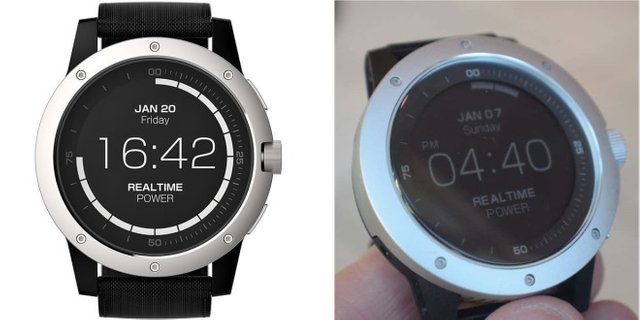
Matrix has been releasing countless shots of the Powerwatch in their promotional material and website, and they all showed a crisp, white-on-black display with flawless contrast. This is borderline to false advertisement, as the final product is nothing like that. There also is a backlight functionality, but the LED is side-mounted and therefore not as effective as it could be; it is also quite weak, and instructions recommend not to use it too frequently as it may drain the power reserve. Let’s say it’s enough for quickly checking time in a dark environment.
There are only two alternative watch faces, none of them memorable
Another feature that was on top of the wish list for a long time. A post on Matrix’s product blog by the end of August 2018 confirmed the feature was a work in progress and even featured an animated image showcasing some prospective design.
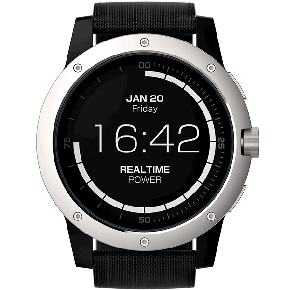 |
|---|
| How new watch faces were advertised |
Alternative watch faces have been delivered with a staged approach; first came an update of the phone app in late November 2018 (which introduced the possibility to set the watch face from the app’s settings). A few weeks later, all watches started receiving the firmware update 2.14 which enabled the new watch faces. While expectations were high, what the update delivered, unfortunately, was not up to it.
In the end, only alternative two faces were released. The first (which had been described as “analog”) was composed of two moving dots to simulate hour and minutes hands in a total-black dial with four marks; even the iconic circular power meter segments that defined the original PowerWatch design were gone.
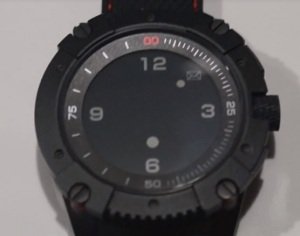
The second (which had been described as “information-heavy for fitness plus watch power”) featured a black/white reverse design that indeed included calories and steps but replaced the circular power meter with a tiny “power bar” that, due to its size, was barely visible and resulted useless most of the time.
On top of that, both faces had lost the indication of the month, day, and date.
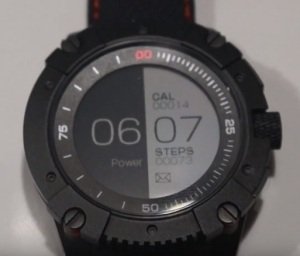
Series 1 customers have been expecting a batch of new designs based on what the company had been suggesting for months, as well as the ability to create custom faces altogether; sadly, that never happened.
(to be continued on part 2)